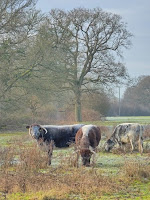The Butterfly Conservation 2012 "End of Year" Brown Hairstreak egg hunt was held on 30th Dec 2012 at Grafton Wood in Worcestershire. 8 of us hardcore Eggheads braved the perilous journey from the carpark across the
fields swamps and even enjoyed a mudbath or two along the way. Sinking, squelching, slipping and sliding, we finally made it to one of the Brownie core areas. After splitting into two teams and being assigned our respective hedgerows, it was decided that some friendly competition was in order: Warwickshire/Shropshire (the A-Team) vs West Midlands (the B-Team). 90 minutes of vigorous searching later, the A-Team were miles ahead with a fantastic 116 eggs.
This total is in fact the best count on this particular hedgerow since the 2001-2002 season and the 4th highest since monitoring began back in 1990. To celebrate, West Midlands Brown Hairstreak champion, Mike Williams, swiftly produced 2 flasks of mulled wine and 2 boxes of Waitrose mince pies. As you can see from the following photograph, i was obviously keen to discuss the size of Brown Hairstreak eggs!

Still sober but rather full after all those pies, we moved onto the next hedgerows which were unfortunately not as prolific as the previous. Never the less, the total for both teams for the day was 171 which is a really fantastic result. After saying goodbye to the rest of the group, 3/4 of the A-Team decided to spend another couple of hours searching a new area of blackthorn we discovered to have eggs for the first time last winter. The good news is we found 32, including another 9 along an adjoining east-facing hedgerow, whereas only 20 were found there last year. Yet another result, bringing the days total to 212!
So far, the 2012/2013 grand total egg count for Grafton Wood amounts to 358 with many more areas left to search.








